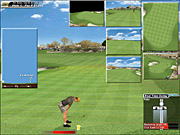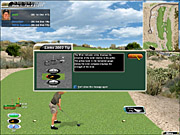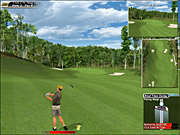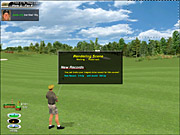One of the most enduring franchises in the history of PC gaming, Links began its storied career in the pre-Windows DOS days of the late 1980s as Links: The Challenge of Golf. It has since been the virtual duffer's de facto standard, due mostly to its precise physics and polished, error-free presentation. Where other golf games have pushed the boundaries with innovations such as mouse-controlled swings, speed play, and lively camera perspectives--sometimes with unsatisfactory results--Links has taken fewer chances and stayed the course, even more so since original designer Access Software was purchased and brought into the Microsoft fold. Two years in development, Links 2003 offers several welcome perks such as real-time swings, substantially cleaner scenery, and an all-new career mode. Yet in many ways it seems like the Links of old. Although the extensive Links camp will quite probably consider it to be the new standard, others may find it somewhat cumbersome and more than a bit bland.

Just like the other games in the series, Links 2003 is not particularly well stocked with golfers. In contrast to the gaggle of players you'll find in EA Sports' Tiger Woods 2002, the game features just four real-life PGA pros--David Toms, Annika Sorenstam, the always-dapper Jesper Parnevik, and the suddenly ineffective Sergio Garcia--and five generic golfers that can be used to piece together a new custom-created player. Indeed, Links offers a wide variety of parameters when fashioning your own player, including skill level, preferred tee, swing type and orientation, club collection, and clothing. You can even import a bitmap image of your own face for the headshots posted at the top of the screen during gameplay.
Links 2003 features a total of six courses, one more than in the previous version. Unlike in Links 2001, you won't find anything truly wild such as the red rock fantasy Mesa Roja, but the half-dozen prebuilt venues still showcase a wide range of environments. The lineup includes such courses as Mexico's Ocean Course at Cabo del Sol, New Zealand's Lodge at Kauri Cliffs, and the fictional Skeleton Coast in Africa. From the wide-open vistas of Gleneagles to the improbable cliffs and ocean-side scenery of Skeleton Coast and the lush surroundings of Cambrian Ridge, there's always something new to grab your attention--at first, anyway.
When the time comes to look beyond the six stock venues, Microsoft has assured that you won't necessarily have to turn to a competing product. For starters, you can take advantage of Links' course converter to import any course from any previous Links game from 1997 to 2001. If that doesn't do the trick, you can use the enclosed Arnold Palmer Course Designer, which lets you shape the land, add fairways and hazards, and generally go wild building your own perfect one-of-a-kind 19-hole layout.
The massive array of objects alone--wherein you don't merely specify a "tree," but the size, shape, and variety of a tree from scores of available alternatives--allows courses to take on unique flavors and attributes that effectively mimic virtually any desired environment. And trees are just the beginning. Links 2001 has a seemingly infinite number of objects from which to choose, including various domesticated and wild animals, people, buildings, fences, sound files, and almost anything else you'd find in the real world.
The course designer also has a sophisticated node-based terrain control system that permits precise and highly detailed modifications to any aspect of major ground-based elements such as fairways and greens. It offers two concurrent real-time perspectives that may be zoomed in or rotated in any direction. And now with the 2003 edition you can blend seams together for more believable object transitions, vary the color and opacity of water, and select and move similar objects in convenient groups. But be warned: The course designer isn't a tool for impatient players. Nonetheless, the stand-alone program purportedly offers the same tools used by the Links team and is certainly quite capable.
And in the actual game, Microsoft has assembled an incredible array of tutorials, aids, and user tips. More than ever before, Links is ready to answer virtually all your questions. You'll particularly appreciate the all-new interactive, narrated lesson segments, which guide you step-by-step through everything from basic shot-making to chipping and putting. Links 2003 offers audio-video hole previews, numerous suggestions, and a heaping helping of swing advice. The game even cautions you in advance if you do something foolish, like forgetting to select a human player for the next round.

Links 2003 opens beautifully, with a dramatic, sweeping symphonic soundtrack reminiscent of one of John Williams' best Star Wars compositions. The game's menus and interfaces are polished and very pretty, but they have too many needlessly convoluted multiscreen operations for some functions. As has come to be expected for this series, the latest edition offers a veritable bounty of game types and rules, including standard match and stroke; several varieties of best ball, skins, scramble, wolf, and Nassau; putt or die (where the only thing that matters is your skill on the putting green); and even the egomaniacal highlight reel. There's plenty more where those came from, and there's an opportunity to concoct your own rules with the returning method-of-play custom game designer.
One parameter you'll definitely want to specify before you take to the fairways is your shot preference. As always, Links features several swing types, including easy swing (wherein you set the direction and let the program handle the rest), standard two- or three-click classic swing, and a mouse-triggered power stroke. However, Links 2003 goes one step further. In perhaps the most important upgrade of the latest edition, Microsoft has finally brought the series into the new millennium by incorporating its own version of the real-time mouse swing. Pioneered several years ago in respected but sadly departed titles such as Sierra's PGA Championship Golf, the real-time mouse swing is a wonderful concept that really pulls you into the game.
Veteran Links players who enjoy the power stroke swing will likely love the new real-time swing. Once engaged, your virtual alter ego responds in tandem with your mouse movements rather than waiting for you to finish your stroke. This, in turn, gives you a far superior gauge through which to plan power and distance. At the higher difficulty settings, you'll have only your own skill and experience to guide you through the process, yet Microsoft has designed the real-time swing so intuitively that even die-hard fans of the antiquated but still popular three-click swing may convert. With a few rounds under your belt, chances are you'll feel very comfortable "swinging" your mouse as you would a club. Just like a real-life golfer on a real-life course, there's nothing but you, your ball, your swing mechanics, and your understanding of current environmental and terrain conditions. It is important to note that the real-time swing does not factor in your tempo and therefore will not penalize you for pausing at the top of your arc, no matter how long that pause might be.

Of course, Links 2003 isn't real life, and sometimes the confines of a 2D viewing screen will play havoc with your depth perception and orientation. Fortunately, Links 2003 has a break-line indicator and an all-new putting assistant. By activating the latter, you're presented with a graphic overlay depicting the perfect trajectory and power. When using the former, you'll see the direction of all pertinent slopes and elevation changes. Both are fine instructional aids that are either unavailable or diminished as you move up in ranks.
In order to incorporate the real-time swing, Microsoft abandoned its preplotted video-based golfers in favor of animated, 3D motion-captured representations that move with you as you manipulate with your mouse. The good news is that Links 2003's new 3D golfers are capable of a range of movements and actions that we simply did not see in the previous games. Now, Sergio will take a mock swing at the cameraman when he muffs a shot, much like the real-world Sergio. He'll stretch and brush up on his stroke while waiting for you to make your move, jump about or pump his fist when he's happy, and kick at the grass when he's not. The actual swing animations are just as fluid and very believable.
Otherwise, Links 2003 doesn't look as vibrant or as animated as you might hope it would. In Links 2003, water does not glisten or ripple. Birds, airplanes, and hot-air balloons do not cut through the sky. Opposing players don't move a muscle when they're in view. Neither do the spectators, even when you can hear them applauding. Trees don't bend, tall grass doesn't sway, and clouds remain perfectly still. Nor is the camera work particularly exciting. Granted, Links has always offered an onslaught of perspectives, but especially in the face of EA Sports' upcoming Tiger Woods, which promises to deliver several spectacular mobile cameras, Links 2003's selection of perspectives seems limited.
Furthermore, the game seems slow and cumbersome. Unlike 2000's PGA Championship, Links 2003 doesn't feature a speed game option that lets computer-controlled golfers shoot in tandem with the human player. The game's courses load slowly, its artificially intelligent opponents spend an inordinate amount of time "thinking" before they shoot, and the game's scene-transition rendering times are surprisingly long, especially if you've opened additional cameras. Moreover, Links 2003's "dynamic" camera view, which merely switches to the ball at the culmination of its run rather than following it throughout its travels, is not available if you've selected the real-time swing option.
Nevertheless, if your computer is fast enough to handle screen resolutions of 1024x768 and above, Links 2003 is a remarkably clean-looking and colorful game. Its scenery is prettier and more believable too, with a greater number of objects and smoother seam-blending between each element. Microsoft has increased the size of the game's textures from 256x256 to 512x512 to further distinguish roughs from fairways and lend a more natural appearance to bunkers, foliage, and trees. But if you run the game on a slower computer, you may never get to experience all the visual upgrades. At resolutions below 1024x768, Links 2003 looks pixelated and ragged.
Links 2003's audio is inconsistent. On one hand, the game fully exploits the benefits of surround sound by funneling its effects across the four-positional soundstage. Players seem capable of a variety of distinctive verbal reactions, and the sound of irons and woods striking golf balls is totally convincing. Unfortunately, Links 2003, like Links 2001 before it, has banished all forms of commentary and play-by-play broadcasts to never-never land. In fact, the only voices you'll hear are those of the golfers. Furthermore, applause and gallery cheers are erratic--accompanying some shots, not accompanying other equally good shots, and suddenly pouncing at full blast rather than ebbing and flowing as real crowd reactions would do.
On a more positive note, the game make you feel like you're part of the big picture. Links 2003's new single-player career mode, in which you'll begin at qualifying school and potentially work your way up to world champion, is a compelling element that effectively mimics real-world parameters and glory. Here, you can choose your events, make a ton of virtual money, and even concoct your own personalized season that'll keep you busy for weeks or months. Regrettably, Microsoft has done away with its virtual tournament, thus forcing you to go through the whole process of starting a career and going through qualifying school all over again, just to partake in a single-player tournament experience. That the game's help documents mistakenly list a virtual tournament as a viable option (as it was in Links 2001) only adds to the frustration.

Just like the previous games, Links 2003 supports a broad range of multiplayer gaming options, including direct connection, e-mail tourneys, casual competitions, and serious competitions on the Microsoft Gaming Zone, and the potentially profitable online Links Tour. We played several holes on several courses at the Zone and found the competition tight and the graphics smooth. Make no mistake--this is a hugely popular game that attracts a massive multiplayer following. A new season specifically designed for Links 2003 owners begins this October.
Links 2003 seems to lack flair, and it may not be satisfying for virtual golfers who want to enjoy an in-game career as the next Tiger Woods. But the game does have numerous upgrades, superb ball physics, and deep gameplay options.